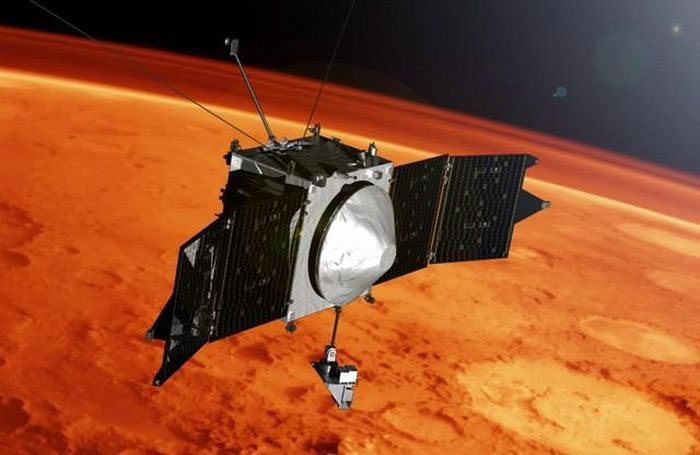The NASA Mars Orbiter MAVEN Captures a Shocking Moment of a “Double Strike” from the Sun Hitting the Planet.
In a recent analysis, American scientists have decoded a strange phenomenon that MAVEN recorded exactly one year ago, on December 26, 2022: A “gap” shooting straight into Mars, causing the planet’s ionosphere and magnetosphere to balloon threefold.
The magnetosphere is an invisible “shell” that envelops the visible sphere of each planet, possessing a powerful magnetic field that protects the planet from harmful cosmic radiation.
Meanwhile, the ionosphere is the ionized part located at the uppermost layer of the planet’s atmosphere.

NASA’s MAVEN Mars Orbiter – (Image: NASA).
According to Science Alert, the authors discovered that the culprits behind this phenomenon were two successive solar winds.
Solar winds carry high-energy particles that often strike planets and can adversely affect anything on those planets, including life. However, on Earth, the strong magnetosphere has protected us.
In the attack on Mars that MAVEN observed, the first solar wind was fairly normal, moving slowly across the planet.
But it was followed by a second, super-fast and energetic solar wind. A dense, chaotic mass of solar particles formed as the two winds rushed through the solar system.
The rapid, powerful movement of these winds temporarily pushed aside stray solar particles in the environment, causing a rapid decrease in the particle density in their path: Full of energy particles while the double wind was blowing, almost empty after they passed through.
This unusual empty gap was accompanied by the phenomenon of Mars’ magnetosphere and ionosphere expanding thousands of kilometers, tripling in size.
This is the second time scientists have captured this phenomenon. The last time was in 1999, when Earth was the victim.
The sudden drop in solar wind particles after a storm passed caused the Earth’s strong magnetic “shell” to swell up to 100 times.
Thus, this new research inadvertently points to the culprit of the 1999 event: it could have been a similar double solar wind.
“When we first saw the data and the sharp drop in solar wind, it was almost unbelievable,” said astronomer Jasper Halekas from the University of Iowa (USA).
According to the researchers, this could provide valuable insights into how atmospheric loss occurs on Mars and similar planets elsewhere in the galaxy.
It may be a crucial piece in determining what makes a planet habitable.




















































